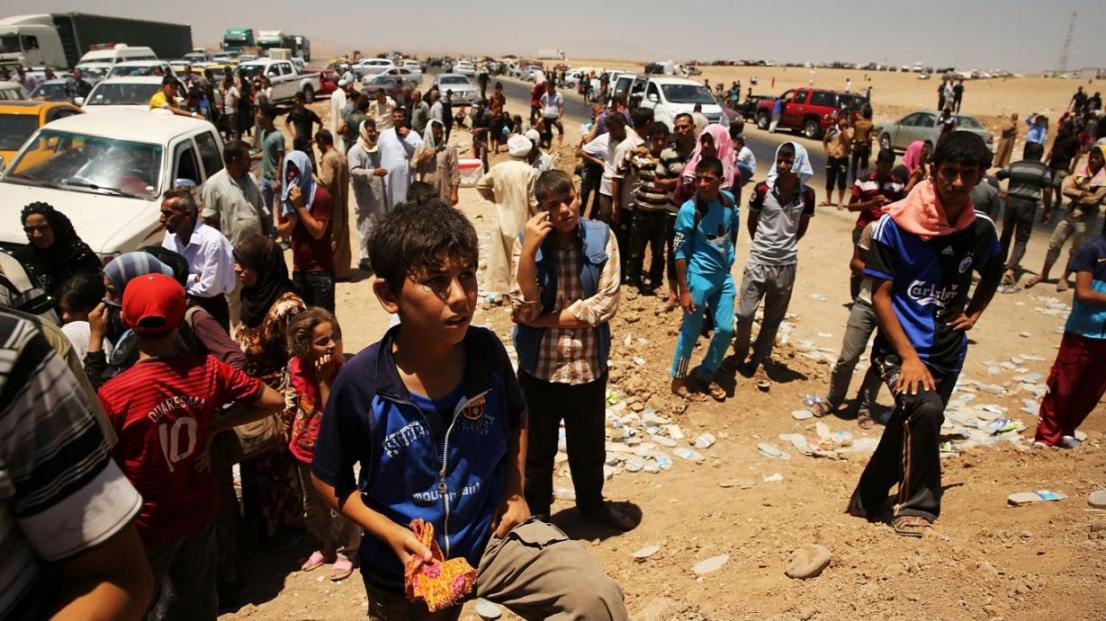Fighting in Iraq’s western Anbar province has forced up to 180,000 people to flee since the city of Hit fell to IS earlier this month, the United Nations said on Monday.
IS militants extended that advance by overrunning a military base that the Iraqi army had abandoned 8 km (5 miles) west of Hit earlier on Monday, according to an army officer and members of a government-backed Sunni militia, according to Reuters.
IS has been on the offensive in the desert province of Anbar, bordering Syria, in recent weeks, taking the town of Hit on Oct. 2 and nearby Kubaisa on Oct. 4.
That has raised concerns because it is close to Baghdad and demonstrates the group’s reach; while operating successfully in Anbar, it is also on the verge of taking the strategic town of Kobane hundreds of miles away in northern Syria on the border with Turkey.
As a result of the fighting and air strikes in Anbar, carried out by the Iraqi government and a US-led military coalition, up to 30,000 families or 180,000 individuals have fled Hit, the UN’s Office for the Coordination of Humanitarian Affairs said.
The war in Anbar and its conquest of Mosul have allowed IS to hold territory from eastern Syria across Sunni parts of Iraq with the goal of establishing a caliphate.
Bombing Campaign
In Baghdad, three bombs exploded in Shi’ite parts of the capital on Monday, killing 30 people, police and medical officials said, continuing a wave of attacks targeting Iraq’s majority religious group.
There was no claim of responsibility for the bombings, but IS claimed a string of attacks in Baghdad on Sunday that left 45 dead.
In northern Syria, three IS militants blew themselves up on Monday in Kobane, a monitoring group said, with the extremists making slight advances inside the besieged Kurdish town.
In one of the attacks, an IS fighter detonated a truck laden with explosives in a northern district of Kobane, which has been the scene of heavy clashes between Kurdish forces and IS members, Kurdish sources said.
The Syrian Observatory for Human Rights monitoring group reported more heavy fighting on Monday inside the city, where US-led air strikes have so far failed to halt the militants’ advance.
Rami Abderahman of the Observatory said one of the suicide attacks targeted a bus station in the northwest of Kobane and that the group had taken around 50 percent of the town.
“They now control the cultural center, which means they have advanced further inside the town,” he said.
The militant group wants to seize the town to consolidate a dramatic sweep across northern Iraq and Syria.
Enslaving Yazidis
The IS says that it has given Yazidi women and children captured in northern Iraq to its fighters as spoils of war, boasting it had revived slavery.
The latest issue of its propaganda magazine Dabiq released on Sunday was the first clear admission by the organization that it was holding and selling Yazidis as slaves.
Tens of thousands of Yazidis, a minority whose population is mostly confined to northern Iraq, have been displaced by the four-month-old offensive in the region.
Yazidi leaders and rights groups warned in August that the small community faced genocide and that threat was put forward by Washington as one of the main reasons for launching air strikes.
Thousands of Yazidis remained trapped on a mountain near their main hub of Sinjar for days in August, while others were massacred and the fate of hundreds of missing women and children remained unclear.
In a report also released on Sunday, Human Rights Watch said abducted Yazidi women were subjected to sexual assault and were being bought and sold by IS fighters.
According to interviews HRW conducted with dozens of displaced Yazidis in the autonomous region of Kurdistan last month and in early October, the IS is holding at least 366 people.
Accounts by some of the Yazidi women who managed to escape and two who are still being held suggest the true number could be at least three times as high.
One 15-year-old girl who escaped on September 7 told HRW that the Palestinian fighter who bought her “told her with pride” that he had paid $1,000 for her.
She said the fighter took her to his flat in the city of Raqa, the group’s main hub in Syria, and sexually assaulted her.
Human Rights Watch said that the extent of the sexual abuse inflicted to enslaved Yazidi girls remained unclear but stressed that the stigma surrounding rape in Yazidi culture could explain the low number of first-hand accounts.
“When you ask them, they were never or rarely sexually assaulted. Simply put, they are scared of being killed by their own tribe,” Hanaa Edwar, a veteran Iraqi rights activist, told AFP.
“So much harm has been done. There needs to be a huge psychiatric campaign to deal with these victims,” she said.


